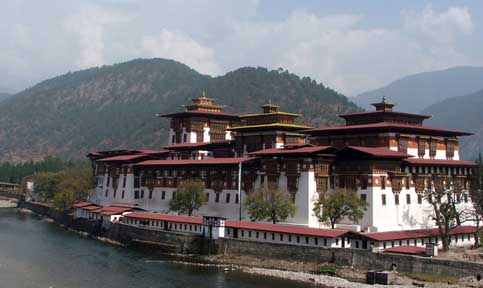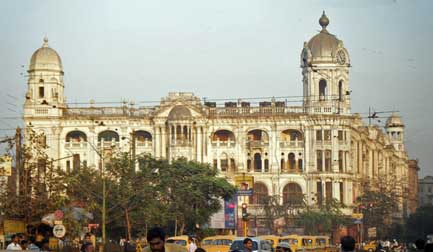I constantly keep a watch on bargains in airfares, and after certain untoward events in Bombay, prices dropped. I don’t have a plan, but guess three weeks should be about right. February is the end of the Indian tourist season (it begins in November), between the end of the monsoon and before the blistering heat of summer (which peaks April-May).
As my departure date approaches, I notice a number of topical items in the news: an man in India has entered the Guinness Book for having the world’s longest ear hair; and an Indian company has announced that they will be introducing a soft drink made from cow urine.
One of the factors that influenced my decision is the non-stop 777 service from Atlanta to Bombay (yeah, yeah, the au currant crowd call it Mumbai). When I bought my ticket the plane was pretty much empty; between then and now Delta has managed to fill up the plane – not with bargain-hunting tourists, but almost 100% Indian-Americans returning for a visit. The meal selection consists of three types of Indian cuisine, but, to drink, only Coca-Cola products, no cow urine soda (yet).
By not having to stopover in Europe the plane lands in the evening instead of the middle of the night. Last time, the process was an ordeal: a decrepit building, long lines, and general chaos. In contrast, there is now a modern terminal. Passport control takes less than a minute. The bags come off the conveyor at a reasonable rate (instead of one bag every few minutes). The flight lasted fifteen hours and we left two hours late, so it is almost midnight, a convenient hour for sleeping.
I have a morning flight so I stay near the airport. A $3 taxi ride takes me to my $10 hotel room -- not lavish but adequate for eight hours of shuteye.
The ride back to the domestic terminal costs well less than $1. The facility has been improved but it still chaotic. There are no proper lounges, no real shopping. At least there are free newspapers, so I catch up on local events. One front-page story reports that tourist arrivals have plummeted and operators are encountering mass cancellations by foreigners (good news for me). Another one was that the cow urine cola announcement sparked a debate on US TV over whether it can cure cancer as claimed by one of the developers and the question of whether one of the potential marketing problems will be its taste.
I am flying to Bhubaneswar, capital of the Indian state of Orissa. It’s a large state on the east coast that used to comprise the southern part of Bengal (but they speak Oriya, not Bengali). My intention is to hire a car and driver and tour the tribal hinterlands in the south. I was going to make my way to Orissa overland but found that would take several days, a problem solved when I found an on-line fare of $61 for a direct flight.
The hotel I choose is not cheap ($36), but has the two modern essentials: air-con and wifi. The cable TV has over a hundred channels, of which approximately 96 are devoted to singing and dancing Bollywood clips. Breakfast is included but it sucks: there are no Froot Loops or waffles; and they need to work on their cornflakes technology – they are like the crumbs at bottom of the box except not as tasty.
I had figured on having a half-day, but, this being India, the plane is late and the first afternoon is lost. (But I don’t miss out on much since everything closes for siesta). In the evening I go to a recommend tour company and strike a deal for a car and driver for six days. The driver is already in the south and will be dropping off passengers, so I will take the overnight train to meet him
Bhubaneswar is known as “The City of Temples.” There sure are a bunch of them, in distinctive Orissa style. In the morning I start a walking tour and, during the day, manage to hit most of the major ones.
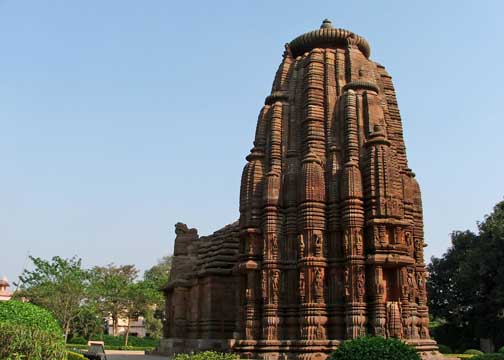
I get another dose of Indian bureaucracy when I go buy a train ticket to get to Calcutta in a week. Tickets for the “ordinary quota” on the train I need are sold out, so I apply under the tourist quota. At the station there are multiple window, including one labeled “Ladies, Physically-challenged, Senior Citizens, VIPs, MPs, ex-MPs, Journalists, and Foreign Tourists”; I join the queue. Most most of the others in line are women fronting for their husbands, who periodically run up with instructions. I am the only foreigner. And you can’t just tell ‘em what you want: you have to fill out a form that looks like a college-application with shortened essay portion. A sign states that a complaints book is available. (My guess is that you have to fill out a form to get it, and even then if they are not out of them you probably have to get the form from the person you are complaining about.) After forty minutes in line I reach the window, where it takes less than a minute to complete the transaction.
The next day I hire a cab to take me on a tour of the surrounding attractions. The first stop is the Sun Temple at Konark. Built in the 13th century, it was sacked in the 15th century and abandoned. Drifting beach sand from the adjacent Bay of Bengal covered and preserved it until it was dug and restored by the British in the 19th century. It’s in the shape of a giant sun chariot with a tower over 200 ft high. At my drivers suggestion I hire a guide, who is proved to be very knowledgeable although his English was incomprehensible. He does a very good job at pointing out the erotic carvings within the amazingly detailed facades.

The Jagganath Temple at Puri is one of the four major pilgrimage temples in India and attracts the faithful from all over. I think the cult (from which our word “juggernaut” is derived) is local – I can’t recall seeing or hearing of Jagganath worship anywhere else. The usual depictions of Jagganath are highly distinctive: always in a trio with his brother and sister, they huge heads and tiny limbs that look like a cross between troll dolls, animated tribal masks, and characters from Southpark.
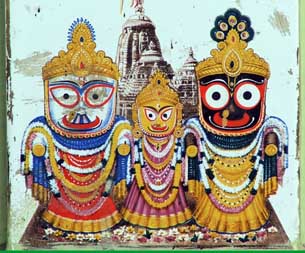
The temple is in the center of the city, but to reach it you must park in a remote lot, take a shuttle, and then run a gauntlet of beggars and hawkers. There are crowds of arriving pilgrims, and everybody is in a festive mood. On the shuttle bus a guy introduces himself as Indian soldier from a place unrecognizable and unpronounceable. He elaborates by telling me that so-and-so hails from his state.
“Who?” I respond.
“You don’t know so-and-so, the railway minister?” he asks incredulously.
Some people ignore the beggars and instead balance coins on the heads of the cows sleeping in the street.
But it all proves to be a bust. Admittance to Jaggernath temple is prohibited for non-Hindus, and a nearby rooftop where one can glimpse over the wall into the courtyard is closed for a three-hour siesta. A high wall surrounds the temple complex. I circumambulate the wall, but at only one point can I even get a glimpse of the central tower.
The final stop is Dhauli, the battlefield where in 260 B.C. Emperor Ashoka, the “founder” of India, won a great victory but then had a revelation of non-violence and resolved to create an empire-of-the-spirit. His inscription to this effect was carved into a rockface and later found by the British and preserved. Atop a nearby hill Japanese peaceniks have built huge stupa (monument), which is surround by cashew nut stands, a connection that escapes me.
That night I board the overnight train to Rayagada, where I will meet my driver. There is no first-class car; the best available is 2-tier air-con 2nd class. There is one of those, one three-tier air-con 2nd class, a couple of non- air-con 2nd class, and a long line of third class sleeper cars. My top-grade berth is comparable to hard-sleeper in China only far less organized. Good thing the journey is only for eight hours.
My driver, Abhi, is waiting at the platform. His English isn’t the best, but he is very conscientious and well-acquainted with the tribal villages we will be visiting. For budgetary and other reasons, I have eschewed hiring a formal guide.
We drive off into the hills of Orissa. For the next six days I will be ensconced in the back seat of a white Ambassador, the doughty and ubiquitous Indian motorcar based on the 1948 Morris Minor and underpowered by a tiny but noisy diesel engine. (Until Indian perestroika, there were no imported cars; without competition there was no incentive to change or improve.) After a couple of hours we arrive at a tribal village, where the children run out to greet us and grab one of the cookies Abhi has brought.
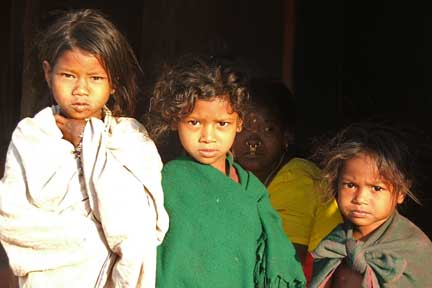
There are about 60 different tribes in Orissa. When first so designated, they were isolated physically, culturally, and religiously from the Hindu mainstream. Nowadays, for the most part, they wear clothes and live much like other people. Government services such a schools, electricity, and bored wells have blurred many of the distinctions, though not all tribes and villages have been equally affected. Some areas are still restricted to outsiders, and some people still look very different. Abhi informs me of the names of the various tribes we visit but it’s all a taxonomic blur. (One of the reasons I declined a guide is I didn’t want to have to pretend to be interested in an unending stream of ethnographic minutia.)
The people are photogenic but not camera-friendly. They hardly ever smile. If not scowling, they usually have a flat expression. People who want their picture taken (so you will send them a copy) are stiff and poker-faced. As might be expected, the kids are somewhat more open.
 |
 |
As we drive around we encounter numerous ad hoc “toll gates” set up to raise “transit taxes” from outsiders to raise money for an upcoming religious festival. The big Shiva festival is in a couple of days and the revenooers are hard at work. Of course, Abhi handles all this (the line item for this on my cost estimate was labeled “parking fees.”
In the late afternoon we reach Jeypore where we will spend the next three nights. Construction of a semi-decent hotel has made this the epicenter of tribal tourism, although it not as busy as the identically-pronounced Jaipur, the tourist destination in Rajasthan -- one night I am the only guest. The motto of the Hello Hotel is “beyond luxury,” which would be accurate of if “beyond” means something other than “more than.” A glance at the rate card reveals a failure to exploit their monopoly market position so I spend an extra $4 to upgrade to an “executive room.”
I have brought with me the batik cloth I bought in December in Malaysia to be made into shirts, so I ask Abhi to find the best tailor in town. Not far from the derelict palace of the Maharajah of Jeypore is the small shop of M. Giri, proud holder of an entry in the Guinness Book of Records. His achievement is having made the world’s largest pair of underpants – I hope he doesn’t make my shirts to match – but he has plenty of other certificates attesting to his mastery of the needle arts. He takes my measurements and quotes me a price: 90 rupees ($1.80)! Obviously, this guy doesn’t have much experience in tourist pricing!
One of the places we visit is Gupteswar, site of a shrine to Shiva. Enroute we pass streams of orange-clad barefoot pilgrims on a multi-day walk to the shrine. (They walk only in the early morning hours; in the afternoon the temperature and the asphalt are too hot.) They will reach the holy spot in time for the festival two days hence, so the bulk are still ten to fifteen miles out.
When we reach the site it is like a Hindu Woodstock in the making. Vendors of every sort are just setting up. The festival draws half a million people. Right now is a good time to visit: when the full crowd arrives it will be unbearable, and the rest of the year it is a big nothing.
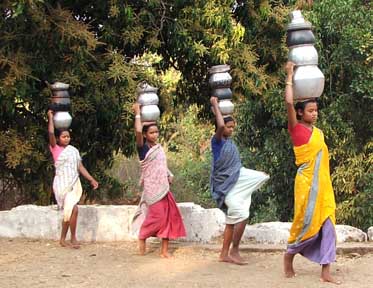
I join the line of pilgrims ascending a long flight of stairs. The shrine itself consists of a rounded rock in a cave. (You are not supposed to take pictures but, since numerous souvenirs with photographic depictions are for sale, I figure the restriction has a commercial rather than religious basis and sneak a shot.). In front of the rock sit three priests. People hand them bags of offerings which are quickly and efficiently processed: cash goes into a dish; rice into a container; coconuts are cracked and the juice poured into another container; and flowers get tossed at the rock. The priests must be sick of eating coconuts by now because they return the shell with the coconut meat along with the empty bag.
On the steps back down there is a long line of beggars seeking money and rice. Usually at these place some entrepreneur will have set up a station selling small coins at a premium; not so here, so from me they get only disappointment.
Over the days we visit several small villages inhabited by different tribes. Abhi is friends with several, and through him I am asked questions such as “Do American women wear saris?” and “Do we use rupees?” We also stop by weekly markets where various tribal members come down from even more remote villages to sell their produce and buy from itinerant vendors. Some vignettes:
• A wandering minstrel walks through the village singing songs from the Ramayama (the great Hindu epic) and people come out and give him a handful of rice which he places in a pot he is carrying.
• It is ration distribution day at another village. They have the thoroughly westernized view that government exists to give out stuff. This being India, there are lots of steps: first a long line to get your ration book stamped and then another next is to get rice (BYO sack)
• One village has a new road through its middle even though the road to it is a disaster and no one in the village has a car. As of two months ago electricity has reached the village, but the only thing electrified is the government office.
• Another village has a large signboard trumpeting various government projects and the number of man-days of work generated. Under this theory of labor, they should just build pyramids.
• In one market, a guy comes up to me and tells me how much he likes Obama and his policies toward India (Huh? What would those be?) Is he concerned that the big O might favor Muslims? “No, just the opposite!” A triumph of hope and hype over evidence.
• In one potters’ village they have to dig the clay, throw a large pot on a wheel, finish it, glaze it, fire it, and take it to market, all for ten rupees. When I show up I am shown primitive little figurines that look like they were made by second-graders (and the slow-learners class at that). Asking price? Fifty rupees.
The highlight of the hills visit is the market where the Bonda people come. These are easily the most exotic of the tribes. Although the men now wear clothes (they used to be naked), the women still wear multiple large metal hoops and heaps of beaded necklaces and not much else.
 |
 |
On the last evening in Jeypore I pick up my shirts. Beautiful! I happily give the man 500 rupees ($10), almost double the amount agreed.
The next day we drive back to Rayagada, stopping inter alia at a market where the tribal women are distinguishable by a multiplicity of metal hair clips.
Although the roads are generally in good condition, travel is slow. As in most of India, a single lane is shared by traffic in both directions, pedestrians, animals, and animal-powered carts, plus cows sitting in the middle of the road oblivious to car horns. There are no bypasses, so we drive through the center of every town where the conduct of commerce spills into the road. It takes two days (with stops) to cover the distance back from Rayagada to Bhubaneswar.

The last night on the road is at Taptapani, a resort area built around hot mineral springs in the Orissa hills, where the government runs the tourism facilities. I take a regular bungalow (sleeps four), but you can get a suite where the smelly sulphur water is piped into a private bath. There are only twelve guest bungalows in the whole complex, and I am the only paying customer. It is not hard to see why: although the setting is very nice, the guest experience is completely Soviet. You have to pay in advance (exact amount, no change), order dinner at check-in (forget about the menu, they don’thave anything that’s on it), and endure frequent power outages. Don’t look for soap or shampoo (the staff probably already sold them), and just try to roust one of the dozens of dozing staff to get you a towel or carry your bag. But it serves its purpose: it creates employment and votes.
Another dose of Orissa Tourist Development Corporation hospitality comes the next day at the restaurant at Chilka Lake, the largest saltwater lake in Asia and our last stop before Bhubaneswar. To my surprise, they are not out of fish – they have one kind available.
After I bought my ticket to Bombay I thought about visiting Bhutan. Some quick email exchanges resulted in a four-day tour beginning with a flight from Calcutta. The plane leaves tomorrow at 8:40 AM. I have a ticket on the “super fast” Puri Express leaving Bhubaneswar at 9:30 PM and due to arrive in Calcutta at 4:40 AM. Four hours to get to the airport should be plenty.
The train arrives only fifteen minutes late. I have a first class ticket, which entire section consists of one-half of one car. It’s comfortable enough. The trouble is that due to fog we are WAY behind schedule. Accompanied by much fretting on my part, we arrive at Calcutta at 7:15. The airport is a forty minute drive, minimum.
I race to a cab. Good thing there is not much traffic at that hour. And good thing that there are no other international flights leaving at that time. When I arrive at the terminal at 8:00 it is as if everyone is expecting me. They rush me through security and to check-in. Made it!






